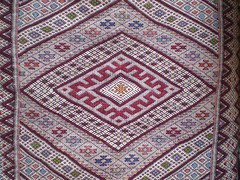Why has The Advocacy Project (AP) partnered with the cooperative of Ain Leuh? After all, AP’s mission is to work toward social justice in marginalized communities with community advocates. The cooperative doesn’t work toward combating female genital mutilation, child sacrifice, or domestic violence. The cooperative isn’t a human rights organization, or information center. The cooperative is a business and their main goal is to increase sales.
At first glance, the members of the cooperative don’t seem marginalized or disempowered. They’re respected members of the Ain Leuh community, are able to send their children to school, and are always surrounded by a supportive group of caring co-workers.
Look a bit closer, though, and you’ll meet women lost outside their small town because of illiteracy. Who are suffering heartbreak over a child who died from infection because access to proper healthcare is inaccessible. Who live in a two-bedroom apartment with 15 other family members. Who experience blurred vision and extreme fatigue because she can’t afford insulin. For many women, the cooperative is what stands between them and extreme poverty.
The textiles the women create are also a preservation of their Amazigh heritage. The technique and many of the design components still used in their work today come from the pre-Islamic tribes of the Middle Atlas. I’ve already learned much about the ancient symbols used in patterns and will write about them soon.
Sales dropped this year, and the president is worried about the future of the cooperative. The small scale of sales has led to a lack of interest in the art of traditional weaving among the younger generation. Many of the cooperative member’s daughters have entered the workforce as hairdressers and tailors, preferring this type of work to the high labor and low profit of weaving.
If the cooperative cannot attract new artisans and find a larger market for their textiles, more than just the families of the women involved in the cooperative will feel the impact. The work of the cooperative benefits the entire Ain Leuh community directly. Shepherds sell their wool to the cooperative, the cooperative hires women to wash and spin the wool into yarn, and seasonal workers are paid to collect plant matter used to dye the yarn.
This is why AP is partnering with the cooperative. To their credit, the women of the cooperative have joined together in a collaborative process as an answer to their economic struggles. The cooperative does not rely on charity or currently any government assistance, benefits from the use of local expertise, and is a space to perpetuate the indigenous culture. AP and my role is to encourage this positive community force by increasing their work’s exposure and by identifying and finding ways to overcome the obstacles to their continued growth.
Posted By Laura McAdams
Posted Jul 1st, 2012



